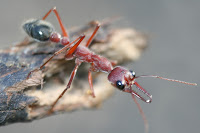 |
| The bacteria was found at this lake. (Beautiful pic) (NASA) |
So I am a few days late on this. On Thursday, NASA announced that they discovered a new type of bacteria that makes us reexamine the conditions necessary for life to exist. The discovery was a bacteria that can use arsenic instead of phosphorus in it's DNA. Here is a link to the
NASA release.
So what. Well, the DNA, which contains the blueprint for an organism to grow, of all previously known life on Earth is made up of only six elements, Carbon, Hydrogen, Oxygen, Nitrogen, Sulfur, and Phosphorus. When astronomers search for lift on other planets, moons, or around other stars, they look for conditions that match what we think life needs to survive. The bacteria NASA discovered reportedly can substitute Arsenic for Phosphorus in it's DNA. Arsenic is highly toxic to most life on Earth. Previously, organisms have been discovered which can survive
high levels of Arsenic, but this is the first claim of one using it to build it's cells. If true, it means it is possible for life to exist with a different set of conditions than we had thought. Very important for those searching the galaxy for life, because not only can the be open to locations with high levels of arsenic, but they have some evidence that even more combinations of elements could lead to life. This is really exciting for scientists and science-fiction readers/writers, who for years have hypothesized that there might be life out there built on different block than we are. We now have some evidence that is it possible. Maybe.
While the news is very exciting, a few places on the internet have gone a little overboard. First, the claims of the bacteria actually using the Arsenic in their DNA is not quite confirmed yet, it is just the most likely hypothesis as of now. It absorbs Arsenic and grows in it's presence, but many more tests are needed to confirm that it actually uses it in DNA, and how it does it.
Nature has a good review.
Second, there is no evidence that this bacteria is alien in origin. At least not any more evidence than all life on Earth came from outer space. See
panspermia for more information.
Likewise, third, this is not evidence that life evolved more than once on Earth independently. This bacteria is probably a mutated form of other previously existing bacteria species, but this has not been proven either way. The lake where it was found was connected other water sources just 10's of millions of years ago, it has not been isolated since like began to develop billions of years ago.
Finally, I do think there is one other implication here that seems to be missing from some discussions. If we have been studying life on Earth and evolution for hundreds of years, and just now found something that may cause us to modify our definition of what is necessary for life, what does it say about our efforts to find life in other places. With it so much more difficult to make observations on Mars, around Jupiter, Venus, or any other planet, who knows what exists that we have just not come across yet. Just because we didn't find life in our first observations on Mars, we can't be sure we have ruled out life being somewhere on that planet.
Here are a couple of the stories explaining the news.
Yahoo News
Mercury News
Popular Science

















.jpg)










